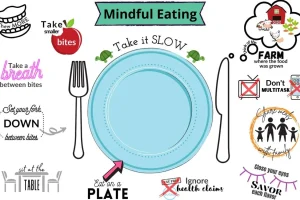Mindful Eating for a Healthier You: Incorporating Whole Foods into Your Diet

Understanding Mindful Eating
Mindful eating is more than just a trend; it’s a transformative approach to enjoying food. It encourages individuals to develop awareness of their eating habits by paying attention to the sensory experience of eating. This means focusing on the taste, texture, and aroma of each bite while also recognizing hunger and fullness cues. Imagine this: You’re sitting at your dining table, a delicious meal in front of you. Instead of scrolling through your phone, you take a moment to inhale the aroma of the dish. You feel the warmth radiating from the food and notice the colorful presentation. As you take your first bite, you savor the flavors and textures—this is the essence of mindful eating. Mindful eating promotes a healthy relationship with food and moves us away from the rush and distraction that often characterize mealtime.
- Mindful Eating for a Healthier You: Incorporating Whole Foods into Your Diet
- Understanding Mindful Eating
- Benefits of Incorporating Whole Foods
- The Basics of Mindful Eating
- Developing Awareness of Eating Habits
- Using Your Senses to Enjoy Whole Foods
- Importance of Whole Foods in Your Diet
- Nutritional Value of Whole Foods
- Impact on Overall Health and Well-being
- How to Transition to a Whole Foods Diet
- Tips for Shopping for Whole Foods
- Easy Ways to Cook with Whole Ingredients
- Mindful Eating Practices for a Healthier Lifestyle
- Mindful Eating During Meals
- Avoiding Emotional Eating with Whole Foods
Benefits of Incorporating Whole Foods
Incorporating whole foods into a mindful eating practice enhances both the experience and health benefits associated with a nutritious diet. Whole foods, which are minimally processed and close to their natural state, are packed with nutrients and flavor. Some reasons why whole foods are essential include:
- Nutritional Powerhouse: Whole foods such as fruits, vegetables, whole grains, and nuts are rich in vitamins, minerals, and antioxidants. These nutrients are vital for maintaining energy levels and supporting the immune system.
- Improved Digestion: Whole foods, particularly those high in fiber like legumes and vegetables, aid in digestion and help prevent constipation. This is essential for maintaining gut health.
- Sustained Energy: Unlike processed foods that might provide a quick sugar spike, whole foods release energy slowly, keeping you fueled over time.
- Weight Management: Mindful eating combined with whole foods can help in achieving or maintaining a healthy weight by promoting healthier choices and fuller satisfaction.
By understanding mindful eating and incorporating whole foods, individuals can cultivate a more intentional eating experience that benefits their overall health and well-being.
The Basics of Mindful Eating
Developing Awareness of Eating Habits
To truly embrace mindful eating, it’s crucial to start by examining personal eating habits. This involves creating a deeper awareness of the patterns that dictate when, where, and how much one eats. Consider this scenario: You’re at a family gathering, surrounded by delicious food. Do you find yourself reaching for snacks mindlessly, or are you savoring each bite? Reflecting on such moments can help identify triggers and habits. Here are a few tips to develop awareness of your eating habits:
- Keep a Food Journal: Write down what you eat, when, and how you feel. Over time, patterns will emerge that can reveal emotional connections or triggers related to food.
- Pause Before Eating: Take a moment to reflect on your hunger before meals. Are you truly hungry, or are you eating out of boredom, stress, or habit?
- Practice Mindful Eating Sessions: Set aside a few moments during the day to eat without distractions. This means putting away devices, turning off the TV, and focusing solely on the meal in front of you.
By consciously observing these habits, one can begin to cultivate a more reflective and intentional approach to eating.
Using Your Senses to Enjoy Whole Foods
Once you’ve developed an awareness of your eating habits, the next step is to engage all your senses while enjoying whole foods. This process not only amplifies the enjoyment of your meals but also reinforces the principles of mindful eating. Here’s how to make the most of your sensory experience:
- Sight: Before diving into your meal, take a moment to appreciate its colors and presentation. Notice how the vibrancy of vegetables can influence your appetite.
- Smell: Inhale the rich aromas wafting from your plate. This triggers your appetite and prepares your body for the meal ahead.
- Touch: Feel the texture of your food. Whether it’s the crunchiness of fresh carrots or the softness of a ripe avocado, texture plays a significant role in the eating experience.
- Taste: Savor each bite by chewing slowly. Allow your taste buds to fully engage with the flavors and explore subtle notes that you might otherwise miss in rushed eating.
- Sound: Pay attention to the sounds of your food, from the crisp crunch of fresh produce to the comforting sizzle of cooking.
Engaging your senses enhances the enjoyment of whole foods, making meals not just a necessity but a delightful experience that nourishes both body and soul.
Importance of Whole Foods in Your Diet
Nutritional Value of Whole Foods
When it comes to fueling the body, the nutritional value of whole foods cannot be overstated. Whole foods, which include fresh fruits, vegetables, legumes, whole grains, nuts, and seeds, are brimming with essential nutrients that processed foods often lack. Take the example of a ripe apple versus an apple-flavored snack. While the snack may satisfy a sweet craving, it doesn’t come close to the fiber, vitamins, and antioxidants found in the whole fruit. Here are some key nutritional advantages of whole foods:
- Rich in Nutrients: Whole foods are packed with vitamins and minerals, which are vital for various bodily functions. For instance, leafy greens like kale are rich in iron and calcium.
- High in Fiber: Foods like oats, beans, and vegetables help maintain digestive health and promote a feeling of fullness, which can aid in weight management.
- Low in Added Sugars and Unhealthy Fats: Unlike many processed foods that are often laden with added sugars, saturated fats, and sodium, whole foods provide a natural source of nutrition without unnecessary additives.
- Phytonutrients: Whole foods contain phytonutrients, which have antioxidant properties. These help combat inflammation and support vital functions in the body.
Impact on Overall Health and Well-being
The benefits of incorporating whole foods into one’s diet extend far beyond basic nutrition; they can significantly enhance overall health and well-being. Individuals who enjoy a diet rich in whole foods often report feeling more energetic, focused, and healthier overall. Consider this: When Sarah replaced processed snacks with whole fruits and nuts, she noticed an improvement in her energy levels and mood. The difference was not just in what she ate, but how she felt. Here’s how whole foods can positively impact well-being:
- Weight Maintenance: Whole foods can help regulate body weight due to their high fiber content and lower caloric density, promoting healthy eating patterns.
- Reduced Risk of Chronic Diseases: Diets high in fruits, vegetables, and whole grains have been linked to a lower risk of conditions such as heart disease, diabetes, and certain cancers.
- Mental Clarity and Mood Stability: Nutrient-rich foods contribute to brain health, influencing mood and cognitive functions. For instance, omega-3 fatty acids found in flaxseeds and walnuts can positively impact mental health.
- Boosted Immune Function: A balanced intake of whole foods helps support the immune system, reducing susceptibility to infections and illnesses.
Incorporating whole foods into your daily diet creates a foundation for better health, fosters a more vibrant lifestyle, and encourages a sustainable relationship with food.
How to Transition to a Whole Foods Diet
Tips for Shopping for Whole Foods
Transitioning to a whole foods diet starts with your shopping habits. This is where the journey towards healthier eating truly begins. The grocery store can be overwhelming, but with a few strategic tips, it can be easier to fill your cart with whole, nutritious foods. When Lisa decided to shift her eating habits, she quickly learned the importance of strategic shopping. Here’s how she approached it, and you can too:
- Create a Shopping List: Before heading to the store, make a list of whole foods you want to buy. Focus on fresh produce, whole grains, legumes, nuts, and seeds.
- Shop the Perimeter: The perimeter of the store typically houses fresh foods. Begin your shopping there, hitting the produce section first, followed by dairy and meats, rather than venturing into the processed food aisles.
- Choose Seasonal and Local Produce: Seasonal fruits and vegetables are not only fresher and more flavorful, but they are often less expensive.
- Understand Labels: Learn to read nutrition labels and ingredient lists. When choosing packaged items, look for those with minimal ingredients that are recognizable and free from preservatives and additives.
- Buy in Bulk: Purchasing grains, beans, and nuts in bulk can save money and help minimize packaging waste.
By adopting these shopping habits, it becomes easier to create a kitchen full of nourishing ingredients.
Easy Ways to Cook with Whole Ingredients
Cooking with whole ingredients doesn’t have to be complicated or time-consuming. In fact, there are many straightforward ways to whip up delicious meals that highlight the natural flavors of whole foods. Imagine hosting a cozy dinner with friends, where the main feature is a colorful, wholesome spread. Here’s how you can bring whole foods to life in your kitchen:
- Batch Cooking: Prepare large quantities of grains like quinoa or brown rice at the beginning of the week. This allows you to easily add them to salads, bowls, or sides throughout your meals.
- Simple Preparations: Roast a variety of seasonal vegetables with a drizzle of olive oil and your favorite herbs. Roasting enhances their natural sweetness and is an effortless way to cook.
- One-Pot Meals: Consider making stews or soups that incorporate whole grains, beans, and plenty of vegetables. Just throw everything into a pot and let it simmer while you relax.
- Smoothies: Blend up a quick smoothie with fresh fruits, leafy greens, and a scoop of nut butter. This is an easy way to ensure you’re getting a range of nutrients in one delicious drink.
- Experiment with Whole Grains: Try using quinoa, farro, or barley in salads or as side dishes. They add texture and nutrients, making meals more satisfying.
Transitioning to a whole foods diet can be both enjoyable and rewarding. With thoughtful shopping and simple cooking methods, anyone can create nourishing meals that support their health and well-being.
Mindful Eating Practices for a Healthier Lifestyle
Mindful Eating During Meals
Now that you’ve made the transition to a whole foods diet and understand the importance of choosing nutritious ingredients, the next step is to practice mindful eating during meals. This practice involves being fully present while eating, which can significantly enhance the mealtime experience and impact overall health. Picture this: it’s a sunny afternoon, and you sit down for lunch at a beautifully set table. Instead of multitasking with your phone or the TV, you focus entirely on the meal. Here’s how to cultivate this mindful eating experience:
- Set the Scene: Create a calming environment. Dine in a space free from distractions, dim the lights, or play soft music to enhance the atmosphere.
- Take a Moment of Gratitude: Before you begin eating, take a few seconds to appreciate the effort that went into preparing your meal. Acknowledge the nourishment it will provide.
- Chew Slowly and Savor Each Bite: Focus on the flavors, textures, and aromas of your food. As you eat, pay attention to how the food makes you feel. This not only enhances enjoyment but also aids digestion.
- Listen to Your Body: Notice your hunger cues and stop eating when you feel satisfied, not stuffed. This practice encourages a balanced approach to portion sizes.
By integrating these mindful eating practices, individuals can foster a greater appreciation for their meals and cultivate a healthier relationship with food.
Avoiding Emotional Eating with Whole Foods
Emotional eating is a common challenge many face, often leading to unhealthy choices and feelings of guilt. However, utilizing whole foods can be a powerful tool in breaking the cycle of emotional eating. When Jenna found herself reaching for sugary snacks during stressful days, she realized it was time to replace her coping mechanism with a healthier outlet. Here’s how to avoid emotional eating with whole foods:
- Identify Triggers: Start by recognizing the emotions that lead to cravings. Keeping a journal can help track patterns and triggers, whether they are stress, boredom, or sadness.
- Keep Healthy Snacks on Hand: Stock your pantry with whole foods that can satisfy cravings without guilt. Nuts, fresh fruits, yogurt, and cut-up vegetables can provide nourishment and curb the desire to snack on processed foods.
- Practice Mindfulness: When you feel the urge to eat emotionally, take a pause. Reflect on whether you are truly hungry or just seeking comfort. A few deep breaths or a short walk can help clarify your feelings.
- Prepare Comforting Whole Food Recipes: Instead of reaching for comfort foods that may be high in sugar or fat, try preparing wholesome comfort dishes. For example, a warm bowl of oatmeal with fruits and nuts can be both satisfying and nourishing.
By shifting focus from emotional triggers to healthier whole food options, individuals can cultivate a more positive relationship with food while promoting overall wellness. Embracing these mindful eating practices can lead to a healthier lifestyle that nourishes both the body and the mind.




